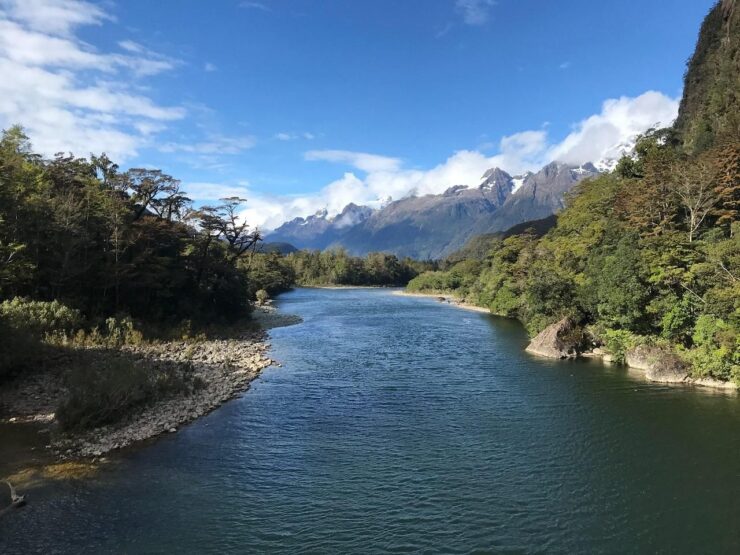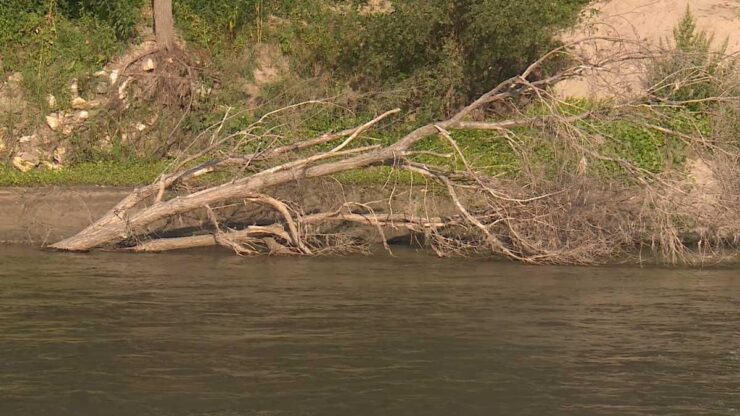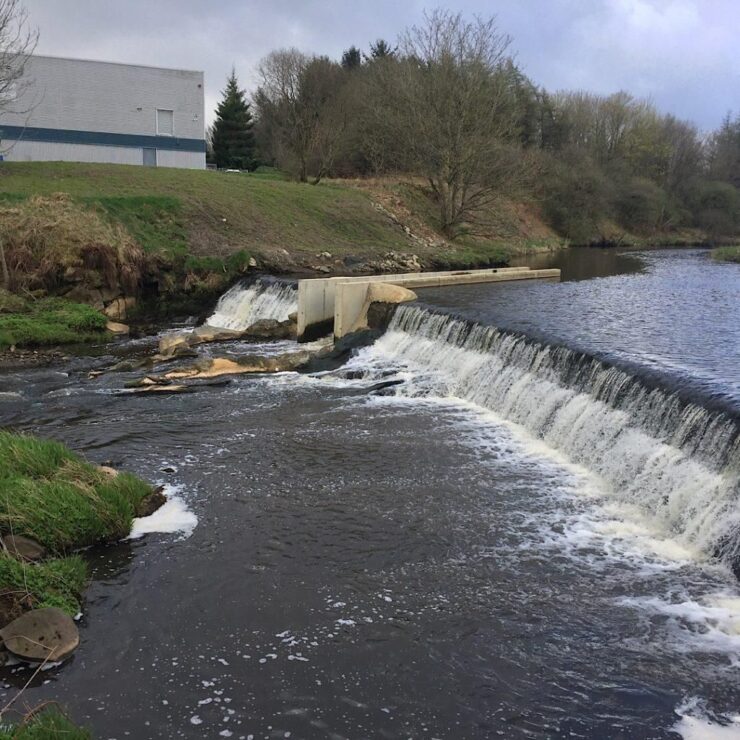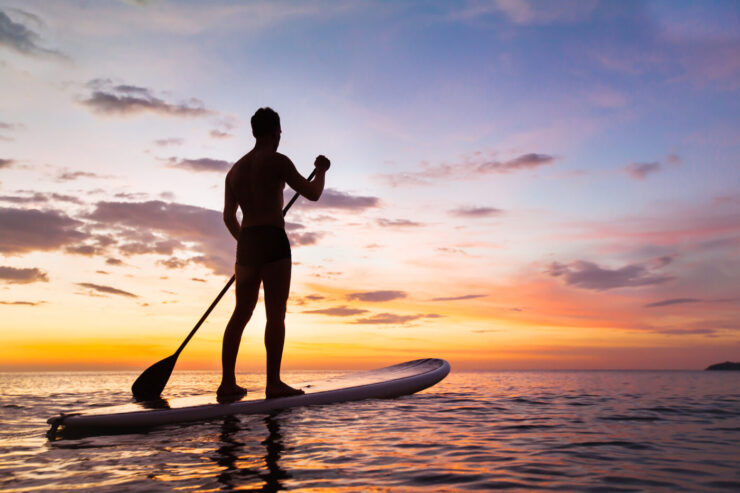In order to stay safe when you are out on the water paddling, you need to understand moving waters as well as how it affects your SUP experience. It will also help ensure you have a good time when you paddle.
Just because the waters you paddle on looks calm doesn’t mean it’s aboslutely safe. No matter how good of a paddler you are, you should be careful whenever you are paddling, even on calm waters.
In this article we will focus on slow-moving waters as fast flowing white waters are more recommended for more experienced and skilled paddlers.
If you are looking for a board to enjoy a leisurely day on the water, Goosehillsport.com has some of the best all-around board for you.
Table of Contents
ToggleWater Flow

Rivers and estuaries usually flow at different speeds and their speed can change every day. The speed of the water flow can be impacted by a number of factors. Don’t assume a river is good to paddle today just because it was perfect to paddle on yesterday. An important variable element is the volume of water flowing. The volume of water flowing is affected by the amount of rain that has fallen over the last few hours or days, or the height and time of the tide. Basically, the higher the water level, the faster the flow. But sometimes low water levels can also produce fast flowing sections.
So we would recommend that you check the water level before actually get out on the water. This step is just as important as checking the tide and weather forecast.
If possible, talk to a local who’s familiar with the river to find out when it’s suitable to paddle. Sometimes the water might look slow, but it could be the opposite of what you think it is.
Even slow-moving waters has its challenges and risks you should be aware of.
What can affect your paddling session?

If you are to paddle out and back to where you start, you need to make sure you can paddle against the flow of water to get back to where you started. If possible, it’s most ideal to start your paddle and paddle upriver against the flow at first, so that your return trip would be much easier.
If you paddle in inland waterways, you will be less affected by the wind than coastal locations but funneling is possible, so make sure you take the effects of the wind as well as the water flow into consideration when you start your paddle.
If you are going to start your paddle at one point and end at another spot, take your time to do your research and choose a route that avoids paddling against wind or flow of the water. Find a suitable exit point that allows you to land and exit the water safely. Also, some inland waterways will require you to have a river license or permit to paddle, so be sure to check before going out. Another thing you should be aware of is that some land alongside the riverbanks is private, so do your research and don’t just assume you can launch and land there.
Be sure to check with local authority or local paddling club to see what requirements there are to paddle on that certain river.
If you are in the UK, you can obtain a river permit easily from several organizations including WSA and the British Canoe Union.
Potential dangers of paddle boarding in slow-moving waters
When out on the water, you should be aware of your surroundings at all times and know the area. Rivers are safe to paddle most of the time, but there are many potential hazards you need to know and prepare for.
Obstructions
There might be obstructions and obstacles like low hanging trees, or man-made structures. If you are paddling in a new place, take time to walk the entire route first and identify any hazards you might want to avoid. Also, ideally, you might want to talk to a local SUP club or paddler to find out as much information as possible.
Weirs
Weirs are barriers dammed across the river. Find out if you will be going anywhere near weirs by checking river maps and maps on your phone. If there really is one on your way, you need to know where you can safely exit the river to walk around it.
You might think weirs look like fun to go down on an inflatable board, but that could be dangerous for you. There might be eddies which can easily hold you under water. There are many different types of weirs and some types even the most experienced paddlers will avoid because of the high risks. If you are not an experienced white water paddler and have enough knowledge and the necessary skill and equipment to run a weir, just stay away from it.
Fishermen
You might not the only person on and around the river. There might be fishermen on rivers so if you do see them, stay alert and give them plenty of space. And keep an eye out for the lines which are usually very hard to see.
Wildlife
There’s a high chance you might encounter wildlife. It’s acutally one of the fun things you get to enjoy when paddling. But it might not be the best idea to get too close. Be respectful, stay away from them and be quiet. Try not to disturb them.
And there might be others sharing the water with you like boaters. Boats usually travel faster than you do, making them much less maneuverable and slower to stop, so you might want to stay out of their way.
Bring safety gear
Whenever you are out paddling, always bring your safety equipment. Use a coiled, quick-release leash for paddling on moving water. A coiled leash stays on your board instead of trailing in the water behind you, therefore, reducing the chances of catching it on debris. Having a quick release allows you to easily, quickly detach yourself from your board in an event of an emergency like getting entrapped. But if you haven’t used a quick-release leash before, practice and make sure you know how to use it correctly.
How to stay safe on slow moving waters when paddle boarding?
In order to stay safe when you are out on the water paddling, you need to understand moving waters as well as how it affects your SUP experience. It will also help ensure you have a good time when you paddle.
Just because the waters you paddle on looks calm doesn’t mean it’s aboslutely safe. No matter how good of a paddler you are, you should be careful whenever you are paddling, even on calm waters.
In this article we will focus on slow-moving waters as fast flowing white waters are more recommended for more experienced and skilled paddlers.
If you are looking for a board to enjoy a leisurely day on the water, Goosehillsport.com has some of the best all-around board for you.
Water Flow
Rivers and estuaries usually flow at different speeds and their speed can change every day. The speed of the water flow can be impacted by a number of factors. Don’t assume a river is good to paddle today just because it was perfect to paddle on yesterday. An important variable element is the volume of water flowing. The volume of water flowing is affected by the amount of rain that has fallen over the last few hours or days, or the height and time of the tide. Basically, the higher the water level, the faster the flow. But sometimes low water levels can also produce fast flowing sections.
So we would recommend that you check the water level before actually get out on the water. This step is just as important as checking the tide and weather forecast.
If possible, talk to a local who’s familiar with the river to find out when it’s suitable to paddle. Sometimes the water might look slow, but it could be the opposite of what you think it is.
Even slow-moving waters has its challenges and risks you should be aware of.
What can affect your paddling session?
If you are to paddle out and back to where you start, you need to make sure you can paddle against the flow of water to get back to where you started. If possible, it’s most ideal to start your paddle and paddle upriver against the flow at first, so that your return trip would be much easier.
If you paddle in inland waterways, you will be less affected by the wind than coastal locations but funneling is possible, so make sure you take the effects of the wind as well as the water flow into consideration when you start your paddle.
If you are going to start your paddle at one point and end at another spot, take your time to do your research and choose a route that avoids paddling against wind or flow of the water. Find a suitable exit point that allows you to land and exit the water safely. Also, some inland waterways will require you to have a river license or permit to paddle, so be sure to check before going out. Another thing you should be aware of is that some land alongside the riverbanks is private, so do your research and don’t just assume you can launch and land there.
Be sure to check with local authority or local paddling club to see what requirements there are to paddle on that certain river.
If you are in the UK, you can obtain a river permit easily from several organizations including WSA and the British Canoe Union.
Potential dangers of paddle boarding in slow-moving waters
When out on the water, you should be aware of your surroundings at all times and know the area. Rivers are safe to paddle most of the time, but there are many potential hazards you need to know and prepare for.
Obstructions
There might be obstructions and obstacles like low hanging trees, or man-made structures. If you are paddling in a new place, take time to walk the entire route first and identify any hazards you might want to avoid. Also, ideally, you might want to talk to a local SUP club or paddler to find out as much information as possible.
Weirs
Weirs are barriers dammed across the river. Find out if you will be going anywhere near weirs by checking river maps and maps on your phone. If there really is one on your way, you need to know where you can safely exit the river to walk around it.
You might think weirs look like fun to go down on an inflatable board, but that could be dangerous for you. There might be eddies which can easily hold you under water. There are many different types of weirs and some types even the most experienced paddlers will avoid because of the high risks. If you are not an experienced white water paddler and have enough knowledge and the necessary skill and equipment to run a weir, just stay away from it.
Fishermen

You might not the only person on and around the river. There might be fishermen on rivers so if you do see them, stay alert and give them plenty of space. And keep an eye out for the lines which are usually very hard to see.
Wildlife
There’s a high chance you might encounter wildlife. It’s acutally one of the fun things you get to enjoy when paddling. But it might not be the best idea to get too close. Be respectful, stay away from them and be quiet. Try not to disturb them.
And there might be others sharing the water with you like boaters. Boats usually travel faster than you do, making them much less maneuverable and slower to stop, so you might want to stay out of their way.
Bring safety gear
Whenever you are out paddling, always bring your safety equipment. Use a coiled, quick-release leash for paddling on moving water. A coiled leash stays on your board instead of trailing in the water behind you, therefore, reducing the chances of catching it on debris. Having a quick release allows you to easily, quickly detach yourself from your board in an event of an emergency like getting entrapped. But if you haven’t used a quick-release leash before, practice and make sure you know how to use it correctly.
Wear a PFD
It’s always recommended to wear a PFD whenever you are out paddling on the water. It will give you more confidence, keep you afloat and possibly save your life in an emergency.
A standard buoyancy aid is recommended for paddling on a river and other moving waters instead of an inflatable waist PFD which requires manual activation.
Rivers and estuaries can offer you with fantastic paddling experience and wildlife viewing opportunities on your SUP board. But it’s important to consider the flow of the water when you plan a SUP trip and when you are actually out on the water to ensure you have a safe and enjoyable SUP session.
Wear a PFD

It’s always recommended to wear a PFD whenever you are out paddling on the water. It will give you more confidence, keep you afloat and possibly save your life in an emergency.
A standard buoyancy aid is recommended for paddling on a river and other moving waters instead of an inflatable waist PFD which requires manual activation.
Rivers and estuaries can offer you with fantastic paddling experience and wildlife viewing opportunities on your SUP board. But it’s important to consider the flow of the water when you plan a SUP trip and when you are actually out on the water to ensure you have a safe and enjoyable SUP session.
Adelaide Gentry, a seasoned kayaking enthusiast and expert, is the driving force behind KayakPaddling.net. With over a decade of experience navigating the world’s most challenging waterways, Adelaide combines her passion for adventure with a deep knowledge of kayaking to provide insightful and practical guidance for paddlers of all levels.
Related Posts:
- 16 Best Kayak For Beginners 2025 - Kayaking Adventure Gear
- 10 Best Fish Finders Under $200 2025 - Top Affordable Picks
- 13 Best Fishing Kayak Under $500 in 2025 -…
- 12 Best Rod For Daiwa BG 5000: - The Right Combo For Reel
- 13 Best Kingfish Reels in 2025 - Pick the Best for You!
- 11 Best Clam Rake for Clam Digging 2025 -…












